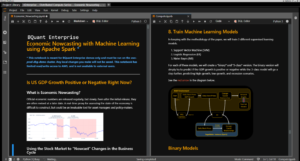
Bloomberg Releases Its Inner Quant as Enterprise Cloud Service

After reaching the limits of MATLAB, a group of quantitative analysts at Bloomberg set out to develop a new system for building and exploring machine learning models. That effort eventually turned into BQuant, a Python-based data science environment designed specifically to help finance professionals crunch data more efficiently. Yesterday, it unveiled BQuant Enterprise, which scales that data science notebook environment to new heights.
Data science is nothing new for Bloomberg, which has been embedding advanced statistics capabilities in its popular Bloomberg Terminal for quite some time. But the story behind the development of BQuant is slightly different.
The story starts back in 2013 with Bloomberg’s Quant Research, a team that’s tasked with incubating new ideas for customer products, troubleshooting customer issues, and generally pushing the boundaries of quantitative analysis. The company used a popular but proprietary data science language, and it was time to move on.
“We reached the limits of what we could do with MATLAB,” Head of Quant Research Bruno Dupire said in a Bloomberg blog post. “We realized we had the tools and knowledge to build our own rich computational environment that could be used to explore financial analyses in multiple dimensions, simultaneously.”
Quant Research tapped the folks in Bloomberg’s Desktop Build Group, which builds custom machine learning models for Bloomberg customers using the Bloomberg Desktop API. This group was looking for tools to speed up development and avoid rewriting boilerplate code. They eventually hammered out a series of new tools, including a data query language called Bloomberg Query Language (BQL), a Bloomberg-specific extension of the D3.js visualization library called bqplot, finance-specific libraries, and bindings to Python and .NET.

BQuant Enterprise brings distributed processing heft to Bloomberg’s Python-based data science notebook environment
The researchers saw the writing on the Python wall back in 2014, and hooked BQuant to the open source iPython group, which would eventually become Jupyter. In addition to being able to write and test Python code in this data science notebook, the BQuant offering gave users access to Bloomberg’s comprehensive financial data.
The desktop version of BQuant has been a success over the years among traders, specifically when it comes to quantitative exercises like factor model evaluation, backtesting strategies, and analyzing portfolios across asset classes. That popularity has grown thanks to the ability to tap into Bloomberg’s growing universe of financial data, including alternative data and geospatial data.
With this week’s launch of BQuant Enterprise, Bloomberg is giving the quantitative tool more scale. Bloomberg runs BQuant Enteprise in a Kubernetes container, which enables it to scale up and down as needed against available cloud resources. It also is integrated with Apache Spark, which gives the offering the parallel processing heft to tackle really big data sets.
“By using distributed computing, users can run tasks overnight on a secure cluster to solve problems that are far beyond the capabilities of a desktop,” Bloomberg says. “In addition, BQuant Enterprise can ingest data from customers’ own data sets or ones they’ve sourced from third parties.”
In addition to packaging these frameworks and libraries into a cloud-based offering, BQuant Enterprise also helps customers monitor user activity, enabling greater oversight into data workflows that become critical to operations.
“Utilizing the power of the cloud, we’re giving clients a turnkey environment where they can connect to their existing systems, bring their own data, mix it with Bloomberg’s comprehensive data sets, and enhance the collaboration of their investment professionals as they test and deploy new quantitative investment strategies,” Shawn Edwards, Bloomberg’s Chief Technology Officer, stated in Bloomberg’s press release.
The hosted offering is already paying dividends to Thornburg Investment Management, an independent investment firm with $49 billion under management. According to Thornburg’s Portfolio Analytics Manager Igor Kuznetsov, the company built its own Web-based data science application, but it couldn’t ingest Bloomberg data.
“After selecting BQuant Enterprise, we were able to bypass those limitations,” Kuznetsov said in Bloomberg’s press release. “My team could immediately access a wide range of normalized data; spend less time manipulating it; apply additional backtesting capabilities; and generate more ideas faster than before.”
Related Items:
How Geospatial Data Drives Insight for Bloomberg Users































